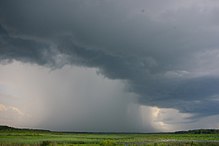
The kulshedra or kuçedra is a water, storm, fire and chthonic demon in Albanian mythology and folklore, usually described as a huge multi-headed female serpentine dragon.[2][1] She is the archetype of darkness and evil, the complementary and opposing force to drangue, the archetype of light and good. The kulshedra is believed to spit fire, cause drought, storms, flooding, earthquakes and other natural disasters against mankind.[3][4]
In Albanian mythology she is usually fought and defeated by a drangue, who is a semi-human winged divine hero and protector of mankind, the most widespread Albanian culture hero.[3] Heavy thunderstorms are thought to be the result of most of their battles.[5] Others include earthquakes, volcanic eruptions and cyclones. In Albanian traditions kulshedra is also fought and defeated by other celestial heroes and heroines, like the Daughter of the Moon and the Sun (E Bija e Hënës dhe e Diellit) who tries to protect her loved one by using her light powers, or other heroic characters marked in their bodies by the symbols of celestial objects,[6] such as Zjermi (lit. "the Fire"), who notably is born with the Sun (Dielli) on his forehead.[7]
The legendary battle of a heroic deity associated with thunder and weather – like drangue – who fights and slays a huge multi-headed serpent associated with water, storms, and drought – like kulshedra – is a common motif of Indo-European mythology.[8] The original legend may have symbolized the Chaoskampf, a clash between forces of order and chaos.[9] In Albanian mythology the legendary battle between drangue and kulshedra is the most famous representation of the dualistic struggle between good and evil, light and darkness,[10] a conflict that symbolises the cyclic return in the watery and chthonian world of death, accomplishing the cosmic renewal of rebirth.[11][2]
In northern beliefs, the kulshedra can take possession of the sun and moon.[4] In southern beliefs, she is described as an enormous female serpent who surrounds the world. According to this version, if she were ever to touch her tail with her mouth, she could destroy the whole world.[3] It is said that she requires human sacrifices for accepting to postpone the natural disasters and catastrophes.[2] Every year she asked for a specific number of young boys and girls from villages (each version has a different number) and every year they never came back until she fought the daughter of the Moon and Sun who ended it for once and for all
According to folk beliefs, the kulshedra's earlier stage is the bolla, which takes the form of demonic serpent possessing both chthonic and aquatic attributes. The bolla's eyes remain shut for the whole year except on Saint George's Day, when it gazes at the world and upon which it will devour any human on sight. The bolla will eventually develop into a kulshedra if it should manage to live for the prescribed number of years without being seen by a human. The bollar and errshaja are considered intermediate forms of this serpent as it goes through a series of metamorphoses. These terms also signify serpents; the term bullar merely being a synonym for bolla in Southern Albania.[12] In some regions the kulshedra is depicted like a female eel, turtle, frog, lizard or salamander.[2][4] There are many tales of brave villagers who dared kill them in their sleep before they became a greater risk.
The kulshedra can also appear disguised as a woman, who keeps her true nature hidden (the devil in disguise). As a semi-human divine figure, she holds also positive qualities that emerge indirectly from Albanian folk tales, beliefs and rituals. It is said that the village where the kulshedra lives has great prosperity in agriculture and livestock. Indeed she absorbs by her breath foodstuffs from everywhere, and her village thrives, while the affected villages become poor and do not prosper. The children of Kulshedra are known as Shlligas and are known to cause storms everywhere they appear. According to folk beliefs people used to practice sacrifices to her so she could bring them good and stop any harmful action.[13]
- ^ a b Doja (2005), p. 451–453.
- ^ a b c d Tirta 2004, pp. 121–132.
- ^ a b c Doja (2005), p. 451.
- ^ a b c Cite error: The named reference
elsie-kulshedrawas invoked but never defined (see the help page). - ^ Cite error: The named reference
durhamwas invoked but never defined (see the help page). - ^ Tirta 2004, pp. 72, 127–128.
- ^ Schirò 1923, pp. 411–439.
- ^ West (2007), pp. 358–359.
- ^ Watkins 1995, pp. 299–300.
- ^ Lelaj 2015, p. 97; Elsie 1994, p. i; Poghirc 1987, p. 179
- ^ Doja 2005, pp. 449–462.
- ^ Elsie 2001a, pp. 46–47, 74–76, 153–156.
- ^ Tirta 2004, pp. 123–125.